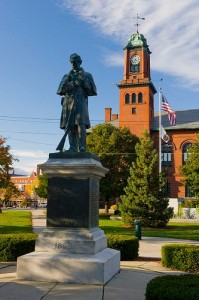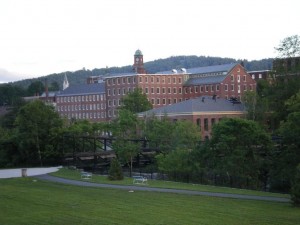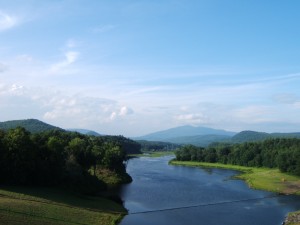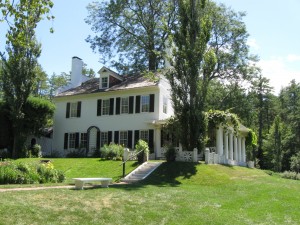Itineraries
Historic Sites
Claremont
Claremont is perched on the banks of the Sugar River several miles upstream from its confluence with the Connecticut River. The town is set out on a series of hills around cascades on the Sugar River where textile mills, constructed in the mid-19th century, stimulated the growth of the city. Claremont today is a diverse community whose attractions range from concerts at the recently restored Claremont Opera House to stock car races at the Claremont Speedway.
Claremont is the Waypoint community for an area that includes Plainfield, Cornish, Unity, Charlestown, and Newport, NH, and Springfield and Weathersfield, VT. Its Waypoint Interpretive Center on North Street offers a panoramic view across the Sugar River to long rows of handsome historic mill buildings, and to the isolated cone of Mt. Ascutney.
The designated Byway routes in the Claremont area are Route 12A in New Hampshire and Route 5 in Vermont.
Nature & Scenery
Mt. Ascutney, a “monadnock” or solitary mountain, dominates the landscape in the Claremont area. Visible from downtown Claremont, as well as much of the valley, it includes a seasonal road to the summit. The Sugar River pours from Lake Sunapee and winds its way through Newport and Claremont before joining the Connecticut. Other tributaries of the Connecticut in the area are the little Sugar River in Charlestown, and the Black River, in Springfield, VT.
Culture
The 1895 Italian Renaissance Revival Structure that houses the Claremont City Hall and Opera House architecturally dominates downtown Claremont. The Opera House offers an interesting performance series in a beautifully restored auditorium. The building is listed on the National Register of Historic Places.
History
In the first decade of the 1800s, a superior breed of sheep was first introduced in the U.S. into pastures across the river from Claremont in Weathersfield, VT. By mid-century, Merino sheep outnumbered the residents of Vermont and New Hampshire, and mills had sprung up in Claremont to produce textiles from their wool. Similar-sized factories established the machine tool industry in nearby Windsor and Springfield, VT. The old textile mills still line the Sugar River and the downtown they spun off is a National Register historic district. There are a number of interesting sites along the Heritage Trail.
The Springfield (VT) Telescope Makers keep alive the traditions established at the Stellafane Observatory a National Historic Landmark. The Observatory played a pioneering role in the development of amateur telescope making and popular astronomy in the United States.
The Eureka Schoolhouse, across the Connecticut in Springfield, is a rare surviving one-room schoolhouse from the late 18th century. A state historic site, it is furnished with school memorabilia. Also on the site is the Baltimore Covered Bridge, built in the Town Lattice format in 1870.
The Salmon P. Chase Birthplace honors a man who served in all three branches of the Federal Government and lived here the first eight years of his life. Before the Civil War, as a U.S. Senator, he fought to end slavery, before serving as Secretary of the Treasury. In 1864 President Abraham Lincoln appointed him Chief Justice of the Supreme Court of the United States.
Recreation
The area has several recreation areas – including Wilgus State Park, the Sugar River Recreational Rail Trail, the Toonerville Trail and the North Springfield Lake/ Stoughton Pond Recreation Area.
Railroads
A towering railroad trestle spans over Route 103, the gateway to Claremont from the Connecticut River bridge at Ascutney, VT. Standing on tall stone piers, the 19th century trestle is a landmark that illustrates the ingenuity and engineering required to construct railroads in the upper Connecticut River Valley.
Claremont is served by an Amtrak stop at a former train station that is about a mile from the downtown.
♦
Windsor
 Located on a bend of the Connecticut River spanned by the longest covered bridge in the country, Windsor is famous as the “birthplace of Vermont” and the home of early innovators in the American industrial revolution. Vermont’s first Constitution was adopted here in 1777. In the following century, in a factory on Mill Brook, Robbins & Lawrence developed a system for creating interchangeable parts. And in the early 20th century, renowned artists drawn to the Valley’s scenic splendor launched a creative tradition that continues today, all presided over by Mt. Ascutney, an ancient volcano.
Located on a bend of the Connecticut River spanned by the longest covered bridge in the country, Windsor is famous as the “birthplace of Vermont” and the home of early innovators in the American industrial revolution. Vermont’s first Constitution was adopted here in 1777. In the following century, in a factory on Mill Brook, Robbins & Lawrence developed a system for creating interchangeable parts. And in the early 20th century, renowned artists drawn to the Valley’s scenic splendor launched a creative tradition that continues today, all presided over by Mt. Ascutney, an ancient volcano.
Windsor is the Waypoint community for an area that includes the towns of West Windsor, Hartland, and Weathersfield, VT, and Cornish and Plainfield, NH. Its Waypoint Interpretive Center is within an historic downtown building across from the Windsor train station.
The designated Byway routes in the Windsor area are Route 5 in Vermont and Route 12A in New Hampshire.
Nature and Scenery
Mt. Ascutney, at 3,144 feet, is the tallest mountain close to the Connecticut River and is the tallest monadnock (single mountain not part of a chain) east of the Mississippi River. It has resisted erosion for millions of years thanks to a composition that includes a granite rare to Vermont and an exposed “ring dike” of cooled lava from its origins as a volcano. A seasonal road and several hiking trails lead to the summit.
White water enthusiasts head to Sumner Falls on the Connecticut River. Now the river is free-flowing, but a dam and canal once stood here, constructed in 1810. They helped to control the movement of logs to sawmills down river and open up the river to flat boats and steam boats that traveled between Long Island Sound and communities as far north as Wells River and Barnet.
The Connecticut’s tributaries in the Windsor area include Mill Brook, which once powered 26 mills, and New Hampshire’s Sugar River, to the south, and Vermont’s Ottauquechee River to the north. Famous Quechee Gorge is a few miles up the Ottauquechee, spanned by an historic bridge that carries Route 4. Here the river cut down 150 feet through bedrock to create a remarkable and visible narrative of geologic time.
History and Culture
The first Constitution of the “Free and Independent State of Vermont” was adopted at Elijah West’s tavern on July 8, 1777. The tavern, now known as the Old Constitution House and “the birthplace of Vermont,” is a Vermont state historic site. Downtown Windsor is an historic district whose architecture includes the stately Windsor House, a former hotel built in 1836 in the Greek Revival style. The Old South Church was designed in 1798 by Asher Benjamin, one of the nation’s most notable architects, whose books exerted a profound influence over the design of Federal-style churches in the Connecticut River Valley and New England. Historic Windsor celebrates and preserves historic architecture.

Windsor and the surrounding area draw their character from the visual presence of Mt. Ascutney and the beauty of the river valley. While history and architecture are strong traditions, the artists who established summer residence in the valley also established the arts as an integral part of the regional flavor. Among the most illustrious artists of the Connecticut River Valley was the sculptor Augustus Saint-Gaudens (1848-1907). The Saint-Gaudens National Historic Site, Cornish, NH, preserves the home, gardens and studios where the sculptor summered from 1885-1897. Among his most well-known works is the Chicago sculpture depicting Abraham Lincoln, the Shaw Memorial in Boston, and the monument to General Sherman in front of New York’s Plaza Hotel. Saint-Gaudens drew into his sphere many other artists and musicians who collectively became known as the Cornish Colony, here at “little New York,” from about 1885-1935. The National Park Service operates the 150 acre site and its hiking trails that explore the park’s natural areas.
Among those drawn to the Cornish Colony was the Parrish family, including popular artist Maxfield Parrish, who created luminous paintings of Connecticut River Valley scenes. Those who live here know that the remarkable lighting for which is work is so well known is a true reflection of the Connecticut River Valley skies. The Town Hall in Plainfield, NH, features the restored stage scenery of Parrish’s design.
Windsor’s “Machine Tool Trail” includes the American Precision Museum a large brick factory, built in 1846, which was the Robbins and Lawrence Armory and Machine Shop. Robbins and Lawrence was an innovator in the new field of manufacturing interchangeable parts, stimulating the growth of mass production and accelerating the industrial revolution in the mid-1800s. The building is a National Historic Landmark due to its importance in the invention of what is known as “precision manufacturing.” The museum preserves the heritage of the mechanical arts, celebrates the ingenuity of our talented forebears, and explores the effects of their work on our everyday lives. It holds the largest collection of historically significant machine tools in the nation.
The Windsor area retains an impressive number of historic covered bridges, including the most notable in the entire length of the Connecticut River, the Cornish-Windsor Bridge. 
The fourth to be built on this site, it is the longest in the U.S. In West Windsor, two covered bridges span Mill Brook: Best’s Bridge and Bowers Bridge Cornish also has 3 smaller covered bridges – Blacksmith Shop Bridge, Dingleton Hill Bridge and Blow-Me-Down Bridge. Weathersfield has the Downers Covered Bridge over the Black River on the western side of town.
Recreation
There are a variety of recreation resources around the Windsor area, including
– Ascutney State Park (Windsor, Weathersfield and West Windsor)
– Sport Trails at Mt Ascutney (West Windsor)
Railroads
Windsor and the region are served by Amtrak, which makes two stops daily at the Windsor-Mount Ascutney train station. The Central Vermont Railway built the Romanesque brick station about 1905.